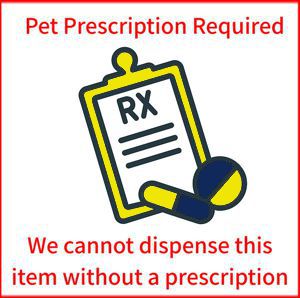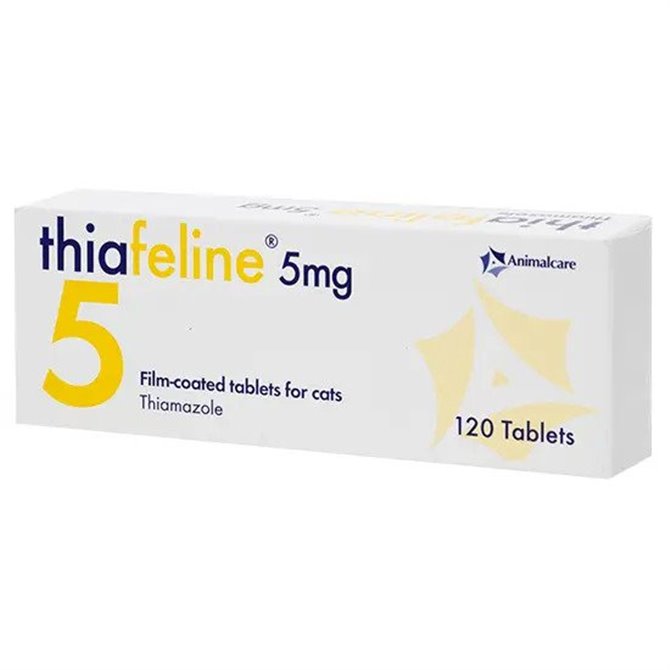
5mg Thiafeline Tablet for Cats - per Tablet
742028
5mg Thiafeline is used for the stabilisation of hyperthyroidism in cats prior to surgical thyroidectomy. It is also used for the long-term treatment of feline hyperthyroidism. Thiafeline may be used alone or in combination with methimazole, a sulphur containing thioamide.
Thiafeline 5mg works by preventing the function of a hormone called thyroxine which increases metabolism, leading to clinical signs such as weight loss, increased appetite, hyperactivity and heart failure.
Thiafeline 5mg for Cats is not just about managing the symptoms but also improving the quality of life for affected cats. Hyperthyroidism can be debilitating, impacting your cat’s physical health and behavioural patterns. By effectively reducing the levels of thyroid hormones, this medication helps in stabilising the cat’s metabolism, leading to weight gain and a reduction in the anxiety and restlessness often associated with this condition.
VETERINARY PRESCRIPTION REQUIRED
Product Features
- Pack Size: - Sold Individually
- Target Animal: - Cat (Feline)
- Related Condition: - Hyperthyroidism in Cats
- Pet Prescription Required?: - Yes
- Active Ingredient: - Thiamazole
- Product Name: - 5mg Thiafeline for Cats
More Information
Description
Thiafeline 5 mg Film-coated Tablets for Cats
Thiafeline may only be supplied with a valid veterinary prescription issued by your vet. You should only purchase Thiafeline if you have or are in the process of arranging such a prescription. See information bar for further details.
5mg Thiafeline for Cats is a specially formulated medication designed to manage and alleviate the symptoms of hyperthyroidism in cats. It contains the active ingredient thiamazole, which works by inhibiting the production of thyroid hormones, thereby restoring the hormonal balance in your cat’s body. Each tablet is crafted with precision to ensure the right dosage, offering a lifeline for cats suffering from this condition.
Thiafeline Tablets contain 5mg Thiamazole. Thiafeline is used for the stabilisation of hyperthyroidism in cats prior to surgical thyroidectomy. Thiafeline is also used for the long-term treatment of feline hyperthyroidism.
Within a short period of administration, many cat owners notice a significant improvement in their cat’s condition. The excessive thirst, increased urination, and hyperactivity often associated with hyperthyroidism begin to subside, and the cat starts to regain its normal behaviour and energy levels.
The administration of Thiafeline 5mg for Cats is straightforward. The small, easy-to-administer tablets can be given directly or mixed with food, ensuring minimal stress for both the pet and the owner. The dosage can be tailored according to the severity of the condition and the cat’s weight, offering flexibility and ensuring that each cat receives the optimal amount of medication for their individual needs.
Do not use Thiafeline in cats suffering from systemic disease such as primary liver disease or diabetes mellitus. Do not use Thiafeline in cats showing signs of autoimmune disease. Do not use Thiafeline in cats with disorders of white blood cells, such as neutropenia and lymphopenia. Do not use Thiafeline in cats with platelet disorders and coagulopathies (particularly thrombocytopenia). Do not use in pregnant or lactating females. Refer to section 4.7. Do not use in cases of hypersensitivity to thiamazole or to any of the excipients. Special warnings for each target species None. Special precautions for use Special precautions for use in animals As thiamazole can cause haemoconcentration, cats should always have access to drinking water. If more than 10 mg per day is required animals should be monitored particularly carefully.
Use of Thiafeline in cats with renal dysfunction should be subject to careful risk : benefit assessment by the clinician. Due to the effect Thiafeline can have on reducing the glomerular filtration rate, the effect of therapy on renal function should be monitored closely as deterioration of an underlying condition may occur. Haematology must be monitored due to risk of leucopenia or haemolytic anaemia. Any animal that suddenly appears unwell during therapy, particularly if they are febrile, should have a blood sample taken for routine haematology and biochemistry. Neutropenic animals (neutrophil counts 75 %. However, there is a considerable variation between animals. Peak plasma levels occur approximately 0.5-1 hour after dosing (tmax = 0.69 h). Cmax is between 1.1 and 2.7 µg/ml (1.78 µg/ml) and half-life is 3.3 h. Distribution From man and rats it is known that Thiafeline can cross the placenta and concentrates in the foetal thyroid gland. There is also a high rate of transfer into breast milk. The drug residence time in the thyroid gland is assumed to be longer than in the plasma. Metabolism and elimination The metabolism of Thiafeline in cats has not been investigated, however, in rats thiamazole is rapidly metabolised in the thyroid gland. About 64 % of the administered dose being eliminated in the urine and only 7.8 % excreted in faeces. This is in contrast with man where the liver is important for the metabolic degradation of the compound. Pharmaceutical particulars List of excipients Thiafeline 2.5 mg Film-coated Tablets for Cats :- Tablet core: Lactose monohydrate Povidone Sodium starch glycolate Type A Silica, colloidal anhydrous Magnesium stearate Coating: Hypromellose Cellulose, microcrystalline Lactose monohydrate Macrogol Titanium dioxide (E171) Carmoisine (E122) Thiafeline 5 mg Film-coated Tablets for Cats :- Tablet core: Lactose monohydrate Povidone Sodium starch glycolate Type A Silica, colloidal anhydrous Magnesium stearate Coating: Hypromellose Cellulose, microcrystalline Lactose monohydrate Macrogol Titanium dioxide (E171) Sunset Yellow FCF (E110) Quinoline Yellow WS (E104) Major incompatibilities Not applicable. Shelf life Shelf-life of the veterinary medicinal product as packaged for sale: 3 years.
Special precautions for storage Keep the blister in the outer package in order to protect from light. Nature and composition of immediate packaging 30 tablets in a cardboard carton containing 1 aluminium/pvcstrips each strip with 30 tablets. 60 tablets in a cardboard carton containing 2 aluminium/pvc strips each strip with 30 tablets. 120 tablets in a cardboard carton containing 4 aluminium/pvc strips each strip with 30 tablets. 150 tablets in a cardboard carton containing 5 aluminium/pvc strips each strip with 30 tablets. 300 tablets in a cardboard carton containing 10 aluminium/pvc strips each strip with 30 tablets. Not all pack sizes may be marketed. Special precautions for the disposal of unused veterinary medicinal product or waste materials derived from the use of such products Any unused veterinary medicinal product or waste materials derived from such veterinary medicinal products should be disposed of in accordance with local requirements. Marketing Authorisation Holder (if different from distributor) Le Vet Beheer B.V. Wilgenweg 7 3421 TV Oudewater The Netherlands Marketing Authorisation Number Thiafeline 2.5mg Film-coated Tablets for Cats Vm 41821/4005 Thiafeline 5mg Film-coated Tablets for Cats Vm 41821/4006
Legal category
Thiafeline is a POM-V (Pet Prescription is Required)
You may also like
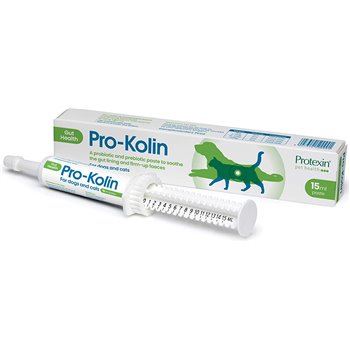
Protexin Pro-Kolin 15ml - ProKolin for Dogs & Cats
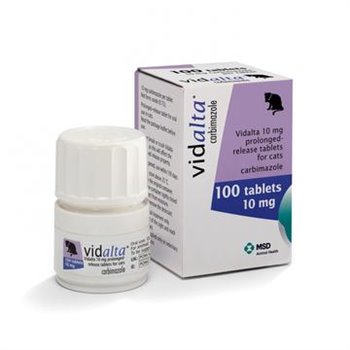
Vidalta 10mg Tablet for Cats - per Tablet
Vidalta 10mg is a prescription medication used to manage hyperthyroidism in cats. It contains the active ingredient carbimazole, which helps regulate excessive thyroid hormone production. Vidalta is designed for long-term use and is available in a controlled-release tablet formulation.
What is Hyperthyroidism in Cats?
Hyperthyroidism is a common endocrine disorder in older cats. It occurs when the thyroid glands produce an excessive amount of thyroid hormones, particularly thyroxine (T4). These hormones regulate metabolism, and when levels become too high, a cat’s body functions accelerate beyond normal rates.
Hyperthyroidism affects multiple organs and systems. The increased metabolic rate can lead to significant weight loss, despite an increased appetite. Cats with this condition often experience behavioural changes, digestive issues, and heart problems if left untreated.
Signs of Hyperthyroidism in Cats
Cats with hyperthyroidism often display noticeable behavioural and physical changes. Common symptoms include:
- Weight loss despite an increased appetite
- Hyperactivity or restlessness
- Excessive thirst and urination
- Vomiting or diarrhoea
- Poor coat condition or hair loss
- Increased heart rate (tachycardia)
- Weakness or muscle wasting
- Changes in behaviour, including aggression or vocalisation
If hyperthyroidism is left untreated, it can lead to secondary complications, including high blood pressure (hypertension), heart disease, and kidney problems.
VET PRESCRIPTION REQUIRED
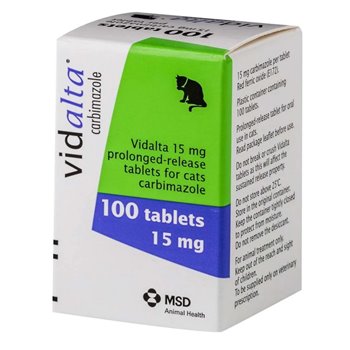
Vidalta 15mg Tablet for Cats - per Tablet
Vidalta 15mg is a prescription-only veterinary medicine used to treat hyperthyroidism in cats. Each modified-release tablet contains 15 milligrams of the active substance carbimazole. The treatment is designed to control the overproduction of thyroid hormones by the thyroid gland, helping to manage the symptoms of hyperthyroidism and improve your cat’s overall health and wellbeing.
What is Hyperthyroidism in Cats?
Hyperthyroidism is a common endocrine disorder affecting middle-aged and older cats. It occurs when the thyroid gland, located in the neck, becomes overactive and produces excessive amounts of thyroid hormones, particularly thyroxine (T4). These hormones regulate the body’s metabolism, so when their levels are too high, the cat’s metabolism speeds up significantly.
The condition is usually caused by a benign tumour on the thyroid gland, known as an adenoma. In rare cases, it can be caused by a malignant tumour. As the disease progresses, it places strain on the heart, liver, kidneys, and other vital organs. Early diagnosis and appropriate treatment are crucial to managing the condition effectively.
VET PRESCRIPTION REQUIRED
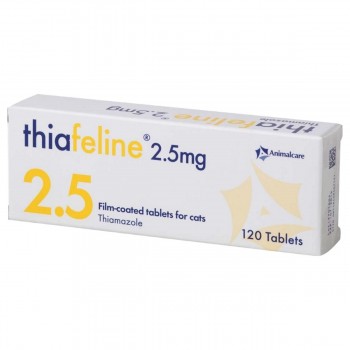
2.5mg Thiafeline Tablet for Cats - per Tablet
2.5mg Thiafeline is used for the stabilisation of hyperthyroidism in cats prior to surgical thyroidectomy. It is also used for the long-term treatment of feline hyperthyroidism.
Hyperthyroidism is a prevalent condition in older cats, characterised by an overactive thyroid gland producing excessive amounts of thyroid hormone. This condition can lead to a range of health issues, including weight loss, increased appetite, and behavioural changes. Hyperthyroidism is a condition where the thyroid gland, located in the cat's neck, produces an excessive amount of thyroid hormone. This overproduction can accelerate the cat's metabolism, leading to symptoms like rapid weight loss, increased appetite, hyperactivity, and increased thirst and urination. If left untreated, hyperthyroidism can lead to severe complications, including heart disease and hypertension.
Thiafeline 2.5mg for Cats contains the active ingredient Thiamazole. Thiamazole acts by inhibiting the production of thyroid hormones in the thyroid gland. By reducing the levels of these hormones, Thiafeline effectively manages the symptoms of hyperthyroidism, bringing relief to affected cats.
VETERINARY PRESCRIPTION REQUIRED




